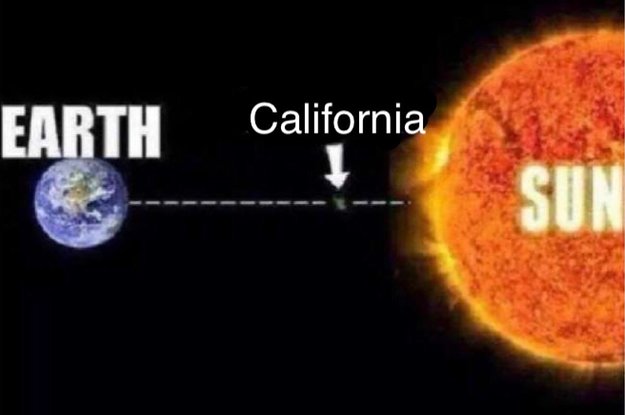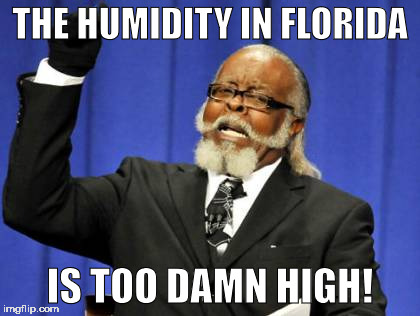We love it.

I'm kidding. I along with most people (Assumption) are not fans of the California heat. It's hot, horribly hot, you can almost fry an egg on the ground hot. Your cars hot, the seats hot, and don't even get me started on the steering wheel....
 Going to summer class (2019 colorized).
Going to summer class (2019 colorized).The average human temperature is 98.6 degrees Fahrenheit or 37 degrees Celsius for everyone else. That is the average though and everyone does have a different base core temperature. Our body regulates our temperature by our sweat glands in our skin. When our brain sense the body is becoming too hot it sends water through the sweat glands. The our sweat evaporates it cools the body down.
Fun Fact: Men generally sweat more than women.

Now it is much easier for us to sweat and better control our body temperatures in more dry weather. (Like our nice west coast [best coast] heat).
Did you Know?
Women have more sweat glands than men do, however mens are more active.
People that are larger in size need to sweat more than smaller people in order to get the same cooling effect.
Some places have a higher level of humidity. Problems can occur when the sweat produced from our sweat glands cannot evaporate. This can lead to heat related illnesses.
 (If you know, you know.)
(If you know, you know.)Time for me to drop some medical K N O W L E D G E.

When the body's core temperature changes it can lead to hyperthermia or hypothermia. Hyperthermia is when the body's core temperature goes above 99.5 degrees Fahrenheit. With an increase of core body temperature it can lead to the following.....

Now on a serious note, as an EMT I cannot stress this enough. When you are outside doing physical activities or its expected to be a hot day out. Drink water. A lot of water. Keep your body hydrated. Replenish lost electrolytes. Eat light meals and snacks. Looking at the assignment module it talks about how more Americans die each year in heat related illnesses rather than cold ones. As an EMT in Souther California I can attest that I have dealt with too many medical emergencies that were caused by heat.
Stay hydrated. Stay informed. Know the signs of heat related illnesses.

The second main version of an Air Conditioner is a Swamp Cooler or evaporative cooler.

The one main thing with swamp coolers is that it is using evaporation to cause a cooling effect. Therefor it is best used in non humid environments (Like Southern California, Nevada, or Arizona).
An interesting fact on an article I found while researching this post.
A study was conducted on the Aborigines population in Australia and the Bantus population in Africa have slower perspiration rate than acclimated and non-acclimated white people.
As always, look out for each other, care for one another, and stay safe.
Your post was very entertaining and interesting, but I had a hard time locating where you addressed all of your point. You can add additional information, but make sure it is *very* clear where you have responded to different prompts so you don't lose points.
ReplyDeleteYou talk a bit about the problems with heat stress but then you jump right into the issue of sweating. Sweating is an adaptation to heat stress and should have been discussed in the second section. The first section was intended to offer you the opportunity to discuss the dangers of heat stress itself, not how the body adapts to heat stress. Think about what happens to the body when its core temperature rises above 98.6 degrees. What happens to the circulatory system and internal organs as they heat up, particularly the brain? Why can't the body function well above these temperatures? This will help your reader understand why adaptations to heat stress are necessary.
You later offer a more extended explanation of the problems with heat stress. This all should have been in the first paragraph.
Adaptation: The second section asks you to identify four specific adaptations to heat stress in humans, one for each of the following categories: Short term, facultative, developmental and cultural. You don't identify which adaptations are which. I'll review what you have:
Sweating: You devote quite a lot of your post to this and what you offer is interesting. This is an example of a short term adaptation to heat stress.
Facultative: You don't offer an example of this type of adaptation to heat stress. An example would be vasodilation. You can find a discussion of this in the assignment module in Canvas.
Developmental: You don't offer an example of this. An example would be a long, lean body shape as explained by Bergmann and Allen's rules. You can find a discussion of this in the assignment module in Canvas.
Cultural: Good discussion on this.
I don't see where you address the final two prompts in the guidelines.
The first asked you to explain some concrete benefits to using the adaptive/clinal approach to understanding human variation. Can knowledge on adaptations to hot climates have medical implications? Help us develop clothing that release heat more efficiently? Can we develop new means of home/building construction that might help decrease heat retention? How can we actually use this information in an applied fashion?
The final question asks if you can use race to understand the traits you discuss. The idea here was to recognize that you *can't* use race for this purpose. Race is not based in biology but is a social construct, based in beliefs and preconceptions, and used only to categorize humans into groups based upon external physical features, much like organizing a box of crayons by color. Race does not *cause* adaptations like environmental stress do, and without that causal relationship, you can't use race to explain adaptations. Race has no explanatory value over human variation.
Hi Sean,
ReplyDeleteAgain your blogs are always entertaining and I like how you deliver additional facts to keep in mind. Such as;
"Fun Fact: Men generally sweat more than women." (Sean).
I honestly didn't know that and I didnt know women have more sweat glands than men. I also agree with Florida being to humid, its the worst in my opinion. Also thank you for your service as an EMT! Moving on, I do understand your adaptations to heat and I agree on reading on your informative post. Lastly, Do you believe you can use race to undertand traits and what are the benefits?
But very good post and creative!
Have a great summer!
- Laura
Thank you for sharing useful information with us. please keep sharing like this. And if you are searching a unique and Top University in India, Colleges discovery platform, which connects students or working professionals with Universities/colleges, at the same time offering information about colleges, courses, entrance exam details, admission notifications, scholarships, and all related topics. Please visit below links:
ReplyDeleteMGAHV, Wardha in Maharashtra
Central University of Tamil Nadu in Thiruvarur
Sri Aurobindo University in Indore
KLE Technological University in Dharwad
Swarnim Gujarat Sports University in Gandhinagar